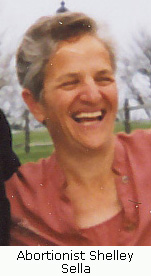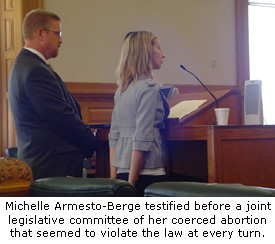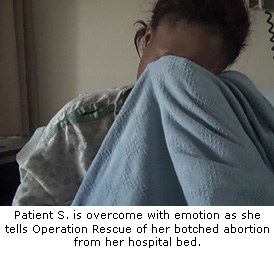This is part three of a five part series "Abortion Capital" delving into the business of lucrative late-term abortions in Albuquerque, New Mexico.
Read Abortion Capital, Pt. 1: The Wild, Wild West Read Abortion Capital, Pt. 2: "Am I Killing? Yes, I am. I know that"

Albuquerque, NM – In March, it was announced that Curtis Boyd, an elderly Texas abortionist, was providing dangerous abortions throughout the latest stages of pregnancy at his Southwestern Women's Options in Albuquerque, New Mexico. That seemed the perfect place for Boyd to establish himself as the late-term abortion "go-to" man in the wake of the death of George Tiller, who had dominated the lucrative late-term abortion market. The state was liberal and had few laws that would hinder his newly expanded business. Late-term abortions are long, complex procedures fraught with risks. If Boyd was going to do large numbers of them, he would need help.
In September, 2009, Boyd hired two abortionists with experience in late-term abortions, Shelley Sella and Susan Robinson. Both had been employed by Tiller in Wichita, Kansas, prior to the closure of his clinic. There, at what had been the world's largest late-term abortion clinic, they were responsible for well over half of all abortions done in the U.S. after 24 weeks.
Troubled Career
Shelley Sella, 52, was born in Tel-Aviv, Israel. She received her education at the liberal University of Wisconsin in Madison, and at the Sackler School of Medicine in Ramat Aviv, Israel. She received her original medical license in 1988.
Sella's first real employment began at Kaiser Permanente in Oakland, California, during which time she also moonlighted at a large community clinic catering to the Hispanic population.
Sella had a troubled career with Kaiser. In December, 1996, Sella was listed as the attending physician during second trimester botched abortion. Her patient, a 28-year old woman who was 16 weeks pregnant, suffered a perforated uterus and other complications as a result of the abortion. A civil suit was filed and later settled out of court for $25,000.
In October, 2000, Sella again found herself in civil court. She was accused of negligent management of a labor and delivery when a patient's uterus spontaneously ruptured, resulting in a dead baby. Kaiser settled out of court for $500,000.
One month after that lawsuit was filed, Sella left Kaiser under a cloud and hired on as an abortionist at Planned Parenthood of Shasta Diablo, in Concord, California, where she continues to work. Since then, Sella has become a "circuit riding" abortionist that currently splits her time between Planned Parenthood, Pregnancy Consultation Center in Sacramento, and Boyd's Southwestern Women's Options in Albuquerque, New Mexico.
Radical Leftist Ideology
Sella has been a financial contributor to a radical California pro-abortion group called ACCESS, Women's Health Rights Coalition. This group's stated goals are to prevent women from patronizing pro-life crisis pregnancy centers and insure greater access to abortion services beyond 20 weeks, or the fifth month of pregnancy and beyond.
Sella is a lesbian who was married to her female lover, Julie Litwin, in a civil marriage service in San Francisco, CA, on Valentine's Day, 2004, in the presence of Litwin's son, who was seven years old at the time. The Sella-Litwin "marriage" was one of dozens of highly-publicized gay civil ceremonies performed in San Francisco in early 2004. Courts later ruled that those "marriages" would not be recognized by the State.
Ironically, Litwin is a certified midwife, a profession that is ironically antithetical to Sella's abortion career.
Sella gained experience in late-term abortions during her eight years of employment at Women's Health Care Services, (WHCS), in Wichita. There, Sella continued to be troubled with botched abortions and other allegations.
Michelle Armesto-Berge

In September, 2007, a former Sella abortion patient came forward and testified before a joint interim legislative committee about her abortion experience. The woman, Michelle Armesto-Berge, told the committee about her hair-raising experience during a coerced second-trimester abortion done by Sella in May, 2003. Armesto-Berge was 18-years old and in her 25th week of pregnancy when her mother coerced her into an abortion that she did not want. Medical records revealed that an injection that was meant to stop her baby's heart had been botched by Sella and had to be re-administered, causing Armesto-Berge additional mental anguish.
A complaint was filed by Operation Rescue President Troy Newman against Sella and her employer, George Tiller in October, 2007, on behalf of Armesto-Berge. The complaint alleged that Sella began the abortion process on Armesto-Berge before consent was obtained. Because Armesto-Berge was late and missed the appointment with the second physician that was required to confirm the medical necessity of all abortions on viable babies after 22 weeks gestation, the complaint alleges that Sella misrepresented the 25-week old baby as being "non-viable."
While Sella's Kansas medical license shows "no derogatory information on file," Sella told the New Mexico Medical Board in her license application that the Kansas Disciplinary Panel "found that a handwritten note for surgical procedures was not legible and insufficient." The Panel asked that Sella complete a record keeping course and start dictating operative procedures. She complied with the recommendations and the case was quietly closed.
35 Week Baby Murder?
But the most shocking allegation against Sella came from a former Tiller employee who came forward in April, 2008, and told Operation Rescue that a baby at 35 weeks gestation was born alive and intentionally stabbed to death by Sella.
Tina David was a licensed practical nurse who often assisted with the late-term abortions. David contacted Troy Newman and told him that she wanted to speak with him about her time at WHCS. David was interviewed by Newman and Cheryl Sullenger. (Listen to the audio clip.) The following is a partial transcript of that conversation:
DAVID: Well, my job, like I said, was hold the leg …
SULLENGER: Uh-huh.
DAVID: And count the parts, if it was in pieces.
SULLENGER: Right.
NEWMAN: Right.
DAVID: And this was…hmmm, maybe 35 weeks?
NEWMAN: Um-hum.
SULLENGER: That's pretty big.
DAVID: Yeah. Yeah. It was – It was a big baby.
SULLENGER: Uh-huh.
DAVID: And…baby came out, and it was moving. I don't know if it was alive or if it was
nerves…I don't – I have no clue.
SULLENGER: Um-hum.
DAVID: Then Dr. Sella looked up right away at me and took a utensil and stabbed it – right
here – [indicating the left rib section] and twisted, and then it didn't move anymore.
NEWMAN: Oh, my goodness!
DAVID: Yeah, and I don't remember—because usually we did the injection.
David could not explain why the baby was born alive since abortions that late in the pregnancy usually begin with a fatal injection into the baby's heart. However, the Armesto-Berge case showed that sometimes the first injection is not always successful.
David told Newman that after her interview with Operation Rescue she spoke with some of her former associates at WHCS. Soon after, she stopped returning Newman's calls.
"Ms. David gave us a very specific eye-witness account about the incident," said Operation Rescue President Troy Newman. "At 35 weeks, there is no doubt about viability. This is murder in anybody's book."
Newman reported the incident to the police, who opened a murder investigation against Sella. A complaint was filed with the Kansas State Board of Healing Arts asking for the suspension of Sella's medical license and the immediate closure of WHCS.
Unfortunately, under questioning by police, Tina David recanted her story. She would only say that she "didn't want to get involved."
"We still believe that the original story that Tina David told us was true based on the fact that we were able to confirm the veracity of nearly everything else she told us. Unfortunately, without Tina, we could never prove it. WHCS had an incinerator onsite where the remains of the baby were cremated. The only physical evidence that may have convicted Sella of murder literally went up in smoke," said Newman.
If David had stuck to her story, it may have saved another abortion patient from the worst experience of her life.
Patient S.

Twenty-three year old Patient S. had been under routine obstetrical care when she decided to abort her baby due to involvement in an abusive relationship. According to her last menstrual period and ultrasounds that she had received, she was 23 weeks pregnant at the time of her abortion, which she began on Tuesday, September 23, 2008. (Read her full story.)
However, she believed that WHCS misdiagnosed her as being only 19 weeks – a difference of an entire month of gestation. According to Kansas law, at 22 weeks, a second physician must concur that the abortion is medically necessary. Patient S. never saw a second physician.
Sella began the abortion on Patient. S. by giving her an injection digoxin into her abdomen, which is meant to stop the baby's heart. Apparently something went wrong with the injection, because Patient S. began feeling sick. She was sent home for the day.
On Thursday, while shaky, sick, and running a fever of 103.7°, she returned to WHCS. According to Patient S., George Tiller, not Sella, completed the abortion, during which Patient S. suffered an asthma attack, respiratory distress, and cardiac arrest. She was revived and hospitalized. She was later treated for a painful yeast infection on her face that another doctor said came from the use of a dirty oxygen mask during her abortion. Patient S.'s mother was present during the abortion and told pro-lifers that she believed that the baby was still alive at the time of the abortion delivery process. If true, that would have made the abortion illegal under the Federal Partial Birth Abortion Ban Act of 2003.
A complaint was filed with the Kansas Board of Healing Arts, which found that Sella did not violate the "standard of care" for her part in Patient S.'s ordeal. With Tiller's death, plans to file a civil suit have been dropped.
"We have three reported incidents where Sella allegedly botched a critical part of the late-term abortion process, leading to major complications each time, yet she has managed to escape responsibility for this," said Newman.
"It is important for the public to know the history here so women can be warned and protected, and so that watchdog groups and authorities can be vigilant. It's only a matter of time before Sella is involved in abortion complications in New Mexico similar to what we have already seen – or worse. It's not a case of 'if, but 'when.'"
Coming soon:
About Operation Rescue®
________________________________
Web site: www.operationrescue.org
